UC Davis Scientists Collaborate With 'Deep Look' on Bindweed Turret Bees
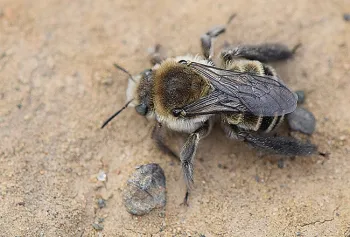
The newly released video, titled “This Fly Torpedoes a Bindweed Bee's Nest,” appears on YouTube at https://youtu.be/gJHCoP4WqMc.
“Shawn has done a lot of work on this bee and with Deep Look, and he also leads our lab's work on Anthophora bomboides, a bumble bee mimic, and studies microbial associates of pollen and solitary bees,” said community ecologist and associate professor Rachel Vannette, a Chancellor's Fellow and vice chair of the Department of Entomology and Nematology.
The Deep Look crew filmed the bees, Diadasia bituberculata, in a nesting area outside the UC Davis Stebbins Cold Canyon Reserve, near Winters.
The bees, also known as digger bees or chimney bees, are specialists on bindweed, commonly known as morning glory. “The females use pollen only from one plant species and are active through the late spring and early summer,” said Vannette, an international leader in microbial ecology who studies interactions between plants, insects and microbes.
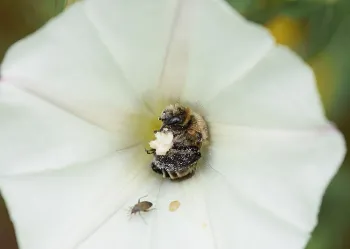
The video shows a female bee fly (family Bombyliidae) hovering over a nest entrance and dropping her eggs inside. The fly eggs hatch into larvae, which eat the bee larvae. Horizontal turrets with sideways entrances (also shown in the video) prevent the flyover egg drop.
Gabriela Quirós, coordinating producer of Deep Look and producer of this video, consulted with the UC Davis scientists, obtaining information on the location of the bee nests, as well as information on the brood cells, pollen, and turrets. The Deep Look production includes UC Davis images taken inside a bee nest.
Quirós also consulted with seven other scientists: Stephen Buchmann, University of Arizona; Andy Calderwood,Ventura County Deputy Agricultural Commissioner; Neal Evenhuis, Bishop Museum of Honolulu, Hawaii; Paul Havemann, UC Davis Natural Reserve System; Keng-Lou James Hung, University of Oklahoma; Doug Yanega, UC Riverside, and James Carey, a naturalist who researches and videos bindweed turret bees in the Santa Monica Mountains National Recreational Area.
Josh Cassidy, Deep Look lead producer and cinematographer, filmed all the footage except for the male bees fighting with each other (00;17;14- 00;25;22 in the video). James Carey, who filmed that footage, “has been regularly monitoring and filming bindweed turret bees since 2016 in Rancho Sierra Vista/Satwiwa, an open space in the Santa Monica Mountains,” Quirós said. “James also filmed the shot at 04;17-04;21 showing nests in the Santa Monica Mountains covered up at the end of the nesting season."
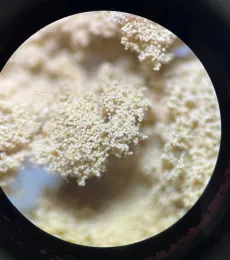
Evenhuis and Calderwood, both bee fly experts, identified the bee flies as Paravilla fulvicoma. “Neal explained the life cycle of these bee flies and advised me on the animation,” Quirós said. Deep Look editor and motion graphics expert Kia Simon created the animation of the bee fly larva eating the bee larva.
“How I got interested in producing an episode of Deep Look about bindweed turret bees was that Rachel Vannette told me about these bees in 2021,” Quirós related. “Rachel told me that Shawn Christensen, a doctoral student in her lab, was studying their pollen. Later, I saw on the Native Bees Facebook group, the videos that James Carey had recorded of bee flies dropping their eggs into the nests of bindweed turret bees in Rancho Sierra Vista/Satwiwa, in the Santa Monica Mountains. I hadn't known about bee flies until I saw his videos.”
“I became interested in trying to film a video about the interactions between bee flies and bindweed turret bees. I contacted Shawn Christensen in January of this year, and Shawn and I started checking in regularly to figure out when the bindweed bees would emerge. When they finally did come out in large numbers--they were later this year than usual--we were, luckily, ready to jump into action and film an episode.”
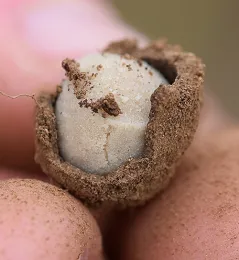
About 70 percent of the world's bee species are ground-nesting. “Females tirelessly scoop earth with their mandibles, softening it by dousing it with nectar they collected earlier,” Deep Look related. “They work side by side, but each is /queen/ of her own castle.”
More than 4,000 species of bee flies comprise the family Bombyliidae. “How do you tell a bee fly from a bee?” Deep Look asked. “Even though bee flies have hairy bodies like bees, if you look closely, you can tell them apart. Bee flies have big eyes that cover a large area of their heads. And bee flies' antennae are short compared to bees' antennae.”
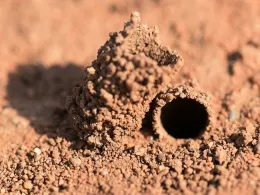
- “The camera work is nothing short of amazing. Great job!” (Cassidy's photography equipment included a 100mm and 65mm macro lenses and a probe lens, a wide angle macro lens.)
- “Love the pollen pants, and I felt so bad for the bees whose hard work was spoiled by those pesky bee flies.”
- “This channel truly deserves much more recognition than it has, the amount of information and clear footage is marvelous.”
- "Thanks. It's not often I see a good short video on a native bee species or any native pollinator for that matter."
Christensen, a member of the UC Davis Microbiology Graduate Group and anticipating his doctorate in the spring of 2024, is an evolutionary biologist turned microbiologist. Christensen also researches other native bees, including Melissodes and Colletes.
Vannette focuses her research on the chemical and microbial ecology of plant-pollinator interactions and how microbes influence plant defense and resistance against insect pests. On its website, the Vannette lab is described as "a team of entomologists, microbiologists, chemical ecologists, and community ecologists trying to understand how microbial communities affect plants and insects--sometimes other organisms, too. We often study microbial communities in flowers, on insects or in soil. We rely on natural history observations, and use techniques from chemical ecology, microbial ecology and community ecology. In some cases, we study applied problems with an immediate application including pathogen control or how to support pollinators.”
